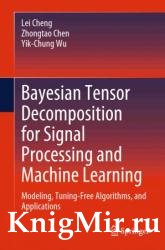Bayesian Tensor Decomposition for Signal Processing and Machine Learning
- Добавил: literator
- Дата: 18-02-2023, 10:05
- Комментариев: 0
 Название: Bayesian Tensor Decomposition for Signal Processing and Machine Learning: Modeling, Tuning-Free Algorithms, and Applications
Название: Bayesian Tensor Decomposition for Signal Processing and Machine Learning: Modeling, Tuning-Free Algorithms, and ApplicationsАвтор: Lei Cheng, Zhongtao Chen, Yik-Chung Wu
Издательство: Springer
Год: 2023
Страниц: 189
Язык: английский
Формат: pdf (true), epub
Размер: 32.0 MB
This book presents recent advances of Bayesian inference in structured tensor decompositions. It explains how Bayesian modeling and inference lead to tuning-free tensor decomposition algorithms, which achieve state-of-the-art performances in many applications, including:
blind source separation;
social network mining;
image and video processing;
array signal processing; and,
wireless communications.
This book starts by reviewing the basics and classical algorithms for tensor decompositions, and then introduces their common challenge on rank determination (Chap. 1). To overcome this challenge, this book develops models and algorithms under the Bayesian sparsity-aware learning framework, with the philosophy and key results elaborated in Chap. 2. In Chaps. 3 and 4, we use the most basic tensor decomposition format, Canonical Polyadic Decomposition (CPD), as an example to elucidate the fundamental Bayesian modeling and inference that can achieve automatic rank determination and hyper-parameter learning. Both parametric and non-parametric modeling and inference are introduced and analyzed. In Chap. 5, we demonstrate how Bayesian CPD is connected with stochastic optimization in order to fit large-scale data. In Chap. 6, we show how the basic model can incorporate additional nonnegative structures to achieve enhanced performances in various signal processing and machine learning tasks. Chapter 7 discusses the extension of Bayesian methods to complex-valued data, handling orthogonal constraints and outliers. Chapter 8 uses the direction-of-arrival estimation, which has been one of the focuses of array signal processing for decades, as a case study to introduce the Bayesian tensor decomposition under missing data. Finally, Chap. 9 extends the modeling idea presented in previous chapters to other tensor decomposition formats, including tensor Tucker decomposition, tensor-train decomposition, PARAFAC2 decomposition, and tensor SVD.
In the Chapter 1, we will first introduce the preliminaries on tensors, including terminologies and the associated notations, related multi-linear algebra, and more importantly, widely used tensor decomposition formats. Then, we link the tensor decompositions to the recent representation learning for multi-dimensional data, showing the paramount role of tensors in modern signal processing and machine learning. Finally, we review the recent algorithms for tensor decompositions, and further analyze their common challenge in rank determination.
The book begins with an introduction to the general topics of tensors and Bayesian theories. It then discusses probabilistic models of various structured tensor decompositions and their inference algorithms, with applications tailored for each tensor decomposition presented in the corresponding chapters. The book concludes by looking to the future, and areas where this research can be further developed.
Bayesian Tensor Decomposition for Signal Processing and Machine Learning is suitable for postgraduates and researchers with interests in tensor data analytics and Bayesian methods.
Скачать Bayesian Tensor Decomposition for Signal Processing and Machine Learning
[related-news] [/related-news]
Внимание
Уважаемый посетитель, Вы зашли на сайт как незарегистрированный пользователь.
Мы рекомендуем Вам зарегистрироваться либо войти на сайт под своим именем.
Уважаемый посетитель, Вы зашли на сайт как незарегистрированный пользователь.
Мы рекомендуем Вам зарегистрироваться либо войти на сайт под своим именем.
